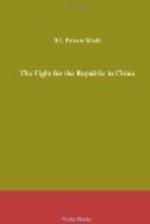View from rear of the Hall of the National Assembly sitting as a National Convention engaged on the Draft of the Permanent Constitution. (Specially photographed by permission of the Speakers for the Present Work)
CHAPTER I
GENERAL INTRODUCTION
The revolution which broke out in China on the 10th October, 1911, and which was completed with the abdication of the Manchu Dynasty on the 12th February, 1912, though acclaimed as highly successful, was in its practical aspects something very different. With the proclamation of the Republic, the fiction of autocratic rule had truly enough vanished; yet the tradition survived and with it sufficient of the essential machinery of Imperialism to defeat the nominal victors until the death of Yuan Shih-kai.
The movement to expel the Manchus, who had seized the Dragon Throne in 1644 from the expiring Ming Dynasty, was an old one. Historians are silent on the subject of the various secret plots which were always being hatched to achieve that end, their silence being due to a lack of proper records and to the difficulty of establishing the simple truth in a country where rumour reigns supreme. But there is little doubt that the famous Ko-lao-hui, a Secret Society with its headquarters in the remote province of Szechuan, owed its origin to the last of the Ming adherents, who after waging a desperate guerilla warfare from the date of their expulsion from Peking, finally fell to the low level of inciting assassinations and general unrest in the vain hope that they might some day regain their heritage. At least, we know one thing definitely: that the attempt on the life of the Emperor Chia Ching in the Peking streets at the beginning of the Nineteenth Century was a Secret Society plot and brought to an abrupt end the pleasant habit of travelling among their subjects which the great Manchu Emperors K’ang-hsi and Ch’ien Lung had inaugurated and always pursued and which had so largely encouraged the growth of personal loyalty to a foreign House.
From that day onwards for over a century no Emperor ventured out from behind the frowning Walls of the Forbidden City, save for brief annual ceremonies, such as the Worship of Heaven on the occasion of the Winter Solstice, and during the two “flights”—first in 1860 when Peking was occupied by an Anglo-French expedition and the Court incontinently sought sanctuary in the mountain Palaces of Jehol; and, again, in 1900, when with the pricking of the Boxer bubble and the arrival of the International relief armies, the Imperial Household was forced along the stony road to far-off Hsianfu.




